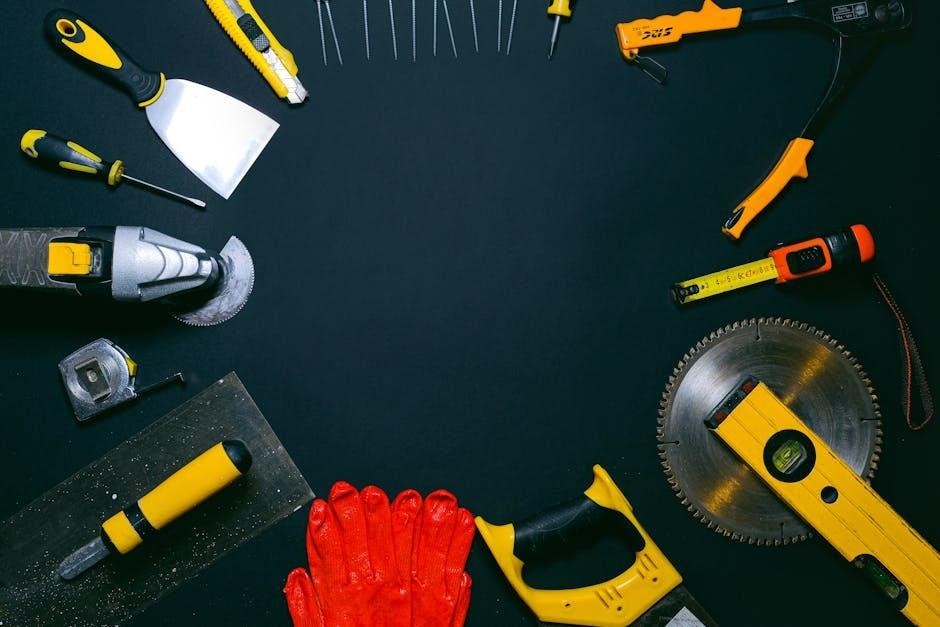Manual tile cutters are tools used to cut tiles, with a
guide
for scoring and breaking, making them essential for various projects, including flooring and walls, with precise cutting and minimal waste, every time, easily.
Overview of Tile Cutter Types
There are several types of tile cutters available, including manual, electric, and hydraulic models. Each type has its own unique characteristics and advantages. Manual tile cutters are the most common type and are suitable for small to medium-sized projects. They are relatively inexpensive and easy to use, making them a popular choice among DIY enthusiasts. Electric tile cutters, on the other hand, are more powerful and efficient, making them ideal for larger projects. They are also more expensive than manual cutters, but offer greater precision and speed. Hydraulic tile cutters are the most advanced type and are typically used in commercial settings. They offer the highest level of precision and efficiency, but are also the most expensive. Understanding the different types of tile cutters is essential in choosing the right one for a particular project. With the right tile cutter, users can achieve professional-looking results and complete their projects with ease and efficiency, using a variety of tools and techniques.
Importance of Choosing the Right Tile Cutter
Choosing the right tile cutter is crucial for achieving professional-looking results and completing projects efficiently. A good tile cutter can make a significant difference in the quality of the cut, reducing waste and saving time. Using the wrong tile cutter can lead to poor cuts, broken tiles, and increased labor costs. It is essential to consider the type of tile being cut, the size of the project, and the level of precision required when selecting a tile cutter. Additionally, considering the cutter’s durability, maintenance, and safety features can help ensure a successful project. By selecting the right tile cutter, users can ensure accurate cuts, minimize errors, and complete their projects with confidence. With the right tool, users can achieve high-quality results, whether working on a small DIY project or a large commercial installation, and using a tile cutter manual can provide guidance on how to use the tool effectively. Proper selection is key to a successful project.

Features of a Good Tile Cutter
A good tile cutter has a sturdy frame, sharp cutting wheel, and accurate guide, ensuring precise cuts and minimal waste, with a comfortable handle, every time, easily, for efficient use.
Key Components of a Tile Cutter
A tile cutter consists of several key components, including a cutting wheel, guide, and breaking point, which work together to score and break the tile, allowing for precise cuts and minimal waste. The cutting wheel is typically made of a durable material, such as steel or tungsten carbide, and is designed to rotate smoothly and consistently. The guide is usually a fixed or adjustable rail that helps to align the tile and ensure accurate cuts. The breaking point is the area where the tile is snapped or broken, and is typically designed to be durable and long-lasting. Additional components, such as a tile holder or support, may also be included to help stabilize the tile during cutting. By understanding the key components of a tile cutter, users can better appreciate the importance of proper maintenance and usage, and can take steps to ensure optimal performance and longevity. Overall, a well-designed tile cutter can be a valuable tool for any tile cutting project.
Benefits of Using a High-Quality Tile Cutter

Using a high-quality tile cutter can provide numerous benefits, including increased accuracy and precision, reduced waste and mistakes, and improved overall efficiency. A good tile cutter can help to ensure that tiles are cut cleanly and evenly, with minimal chipping or cracking, resulting in a professional-looking finish. Additionally, a high-quality tile cutter can be safer to use, with features such as secure tile holding and smooth cutting actions, reducing the risk of injury or accident. Furthermore, a well-made tile cutter can be more durable and long-lasting, withstanding the demands of frequent use and providing a longer lifespan. By investing in a high-quality tile cutter, users can enjoy these benefits and achieve better results in their tile cutting projects, whether for personal or professional use. This can lead to increased satisfaction and confidence in their work, as well as a sense of pride in their accomplishments.

How to Use a Tile Cutter Effectively
Use a tile cutter with a stable base and secure tile holding for effective cutting, ensuring accurate results, every time, with minimal effort, using proper techniques, and following guidelines.
Preparation and Safety Precautions
To ensure safe and effective use of a tile cutter, it is essential to take certain precautions. First, read the manual carefully and understand the operating instructions. Wear protective gear such as gloves and safety glasses to prevent injury from sharp edges and flying debris. Ensure the workspace is clean and clear of obstacles, and the tile cutter is placed on a stable and level surface. Check the tile cutter for any damage or wear, and perform regular maintenance to prevent accidents. It is also crucial to follow proper cutting techniques and use the correct blade for the type of tile being cut. Additionally, keep loose clothing and long hair tied back, and avoid wearing jewelry that may get caught in the machine. By following these preparation and safety precautions, users can minimize the risk of injury and ensure a successful tile cutting experience. Proper preparation is key to safe operation.
Step-by-Step Guide to Cutting Tiles
To cut tiles effectively, start by placing the tile on the cutter’s base, ensuring it is secure and stable. Next, carefully align the cutting wheel with the desired cut line, using the guide to achieve accurate placement. Gently score the tile, applying gentle to moderate pressure, depending on the tile type and cutter model. Then, use the breaking mechanism to snap the tile along the scored line, taking care not to apply too much pressure, which can cause the tile to break unevenly. After cutting, use a tile file to smooth the edges and remove any sharp burrs or debris. It is also essential to clean the cutter regularly to maintain its performance and extend its lifespan. By following these steps and using the right techniques, users can achieve professional-looking results and complete their tile cutting projects efficiently. Proper cutting techniques are crucial for successful tile installation.

Tips for Cutting Different Types of Tiles
Cutting various tile types requires specific techniques and tools, ensuring accurate cuts and minimal waste, every time, with a manual tile cutter, for different tile materials and sizes, easily.
Cutting Porcelain and Ceramic Tiles
Cutting porcelain and ceramic tiles requires a bit more effort and technique, but with the right tools and knowledge, it can be done efficiently. A manual tile cutter is a great option for cutting these types of tiles, as it allows for precise cuts and minimal waste. When cutting porcelain and ceramic tiles, it’s essential to use a sharp blade and to apply gentle pressure, increasing as needed. The tile should be placed on a stable surface, and the cutter should be guided smoothly and evenly. It’s also important to wear protective gear, such as gloves and safety glasses, to prevent injury. Additionally, using a tile nipper can be helpful for cutting small curves or irregular shapes. By following these tips and using the right tools, cutting porcelain and ceramic tiles can be a straightforward process, and the results will be professional-looking and long-lasting, with clean cuts and no damage.
Cutting Curves and Other Angles
Cutting curves and other angles can be a challenging task, but with the right techniques and tools, it can be accomplished with ease. A tile cutter with a curved cutting guide or a diamond-tip drill bit can be used to cut intricate curves and shapes. To cut curves, the tile should be slowly and carefully moved along the curved guide, applying gentle pressure. For other angles, such as bevels or miters, a specialized cutting tool or a wet tile saw can be used. It’s essential to use a steady hand and to follow the manufacturer’s instructions for the specific tool being used. By taking the time to carefully plan and execute the cut, it’s possible to achieve professional-looking results with curved and angled cuts. With practice and patience, cutting curves and other angles can become a routine part of tile cutting, allowing for more complex and creative designs to be realized, and adding an extra layer of sophistication to any tile installation project.